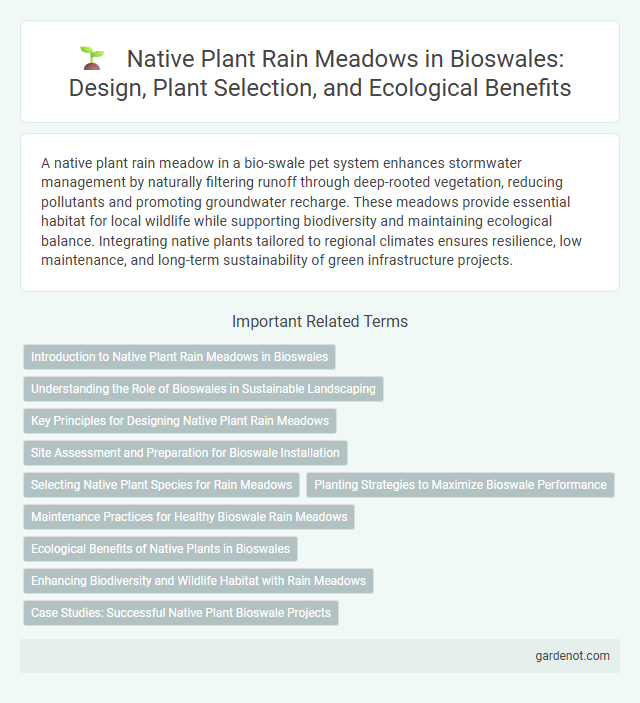A native plant rain meadow in a bio-swale pet system enhances stormwater management by naturally filtering runoff through deep-rooted vegetation, reducing pollutants and promoting groundwater recharge. These meadows provide essential habitat for local wildlife while supporting biodiversity and maintaining ecological balance. Integrating native plants tailored to regional climates ensures resilience, low maintenance, and long-term sustainability of green infrastructure projects.
Introduction to Native Plant Rain Meadows in Bioswales
Native plant rain meadows in bioswales enhance stormwater management by utilizing deep-rooted native vegetation to improve soil infiltration and reduce runoff. These meadows support local ecosystems by providing habitat for pollinators and other wildlife while filtering pollutants from rainwater. Incorporating native plant species in bioswales promotes sustainable water practices and enhances urban green infrastructure resilience.
Understanding the Role of Bioswales in Sustainable Landscaping
Bioswales use native plant rain meadows to enhance water absorption and filtration, reducing urban runoff pollution while supporting local biodiversity. These rain meadows, composed of deep-rooted native plants, improve soil permeability and prevent erosion, making them essential elements in sustainable landscaping. Integrating bioswales with native vegetation promotes natural water cycles and contributes to resilient, eco-friendly urban environments.
Key Principles for Designing Native Plant Rain Meadows
Key principles for designing native plant rain meadows include selecting deep-rooted native species to enhance water infiltration and soil stability, which reduces runoff and filters pollutants efficiently. Incorporating diverse plant heights and flowering periods supports local biodiversity and improves habitat resilience. Proper site assessment ensures optimal placement for managing stormwater flow while complementing existing landscapes and ecological conditions.
Site Assessment and Preparation for Bioswale Installation
Site assessment for native plant rain meadow bioswale installation involves analyzing soil composition, drainage patterns, and sunlight exposure to ensure optimal plant growth and water infiltration. Preparing the site includes removing non-native vegetation, grading the land for proper water flow, and amending the soil with organic matter to enhance permeability and nutrient availability. This careful evaluation and preparation are essential to establish a functional and sustainable bioswale that supports native biodiversity and effective stormwater management.
Selecting Native Plant Species for Rain Meadows
Selecting native plant species for rain meadows enhances water absorption and supports local biodiversity by providing habitat for pollinators and wildlife. Choose deep-rooted grasses and wildflowers adapted to the region's soil and hydrology to improve stormwater filtration and soil stabilization. Incorporating a diverse mix of perennial natives ensures seasonal interest, resilience to pests, and a balanced ecosystem in bio-swale rain gardens.
Planting Strategies to Maximize Bioswale Performance
Incorporating native plant rain meadows enhances bioswale performance by leveraging deep-rooted grasses and diverse herbaceous species that improve soil infiltration and nutrient uptake. Strategic layering of plants with varying root depths maximizes water retention and supports microbial activity, reducing runoff and filtering pollutants effectively. Selecting drought-tolerant and flood-resilient native species ensures long-term stability and ecological balance within bioswale systems.
Maintenance Practices for Healthy Bioswale Rain Meadows
Native plant rain meadows in bioswales require regular monitoring to ensure soil moisture levels support plant health and pollutant filtration. Periodic removal of invasive species and dead plant material promotes biodiversity and prevents clogging of water flow paths. Mulching with organic materials enhances soil structure, conserves moisture, and reduces erosion, sustaining the ecological function of rain meadows.
Ecological Benefits of Native Plants in Bioswales
Native plant rain meadows in bioswales enhance water infiltration, reduce erosion, and filter pollutants, improving overall water quality. Deep root systems of native vegetation stabilize soil and create habitats for diverse wildlife. Their adaptability to local climates ensures long-term sustainability and reduces maintenance needs.
Enhancing Biodiversity and Wildlife Habitat with Rain Meadows
Native plant rain meadows in bio-swales significantly enhance biodiversity by providing diverse habitats for local wildlife, including pollinators and amphibians. These rain meadows improve water infiltration and filtration, reducing runoff and supporting ecological balance. Integrating native flora into rain meadows promotes resilient ecosystems that sustain wildlife populations and improve urban green infrastructure.
Case Studies: Successful Native Plant Bioswale Projects
Native plant rain meadows integrated within bioswales have demonstrated exceptional stormwater management and ecological benefits in urban settings. Case studies in cities like Portland, Oregon, and Seattle, Washington, reveal significant reductions in runoff volume and improved water quality through deep-rooted native grasses and wildflowers. These projects also enhance biodiversity, support pollinators, and reduce maintenance costs compared to traditional landscaping approaches.
Native plant rain meadow Infographic

 gardenot.com
gardenot.com